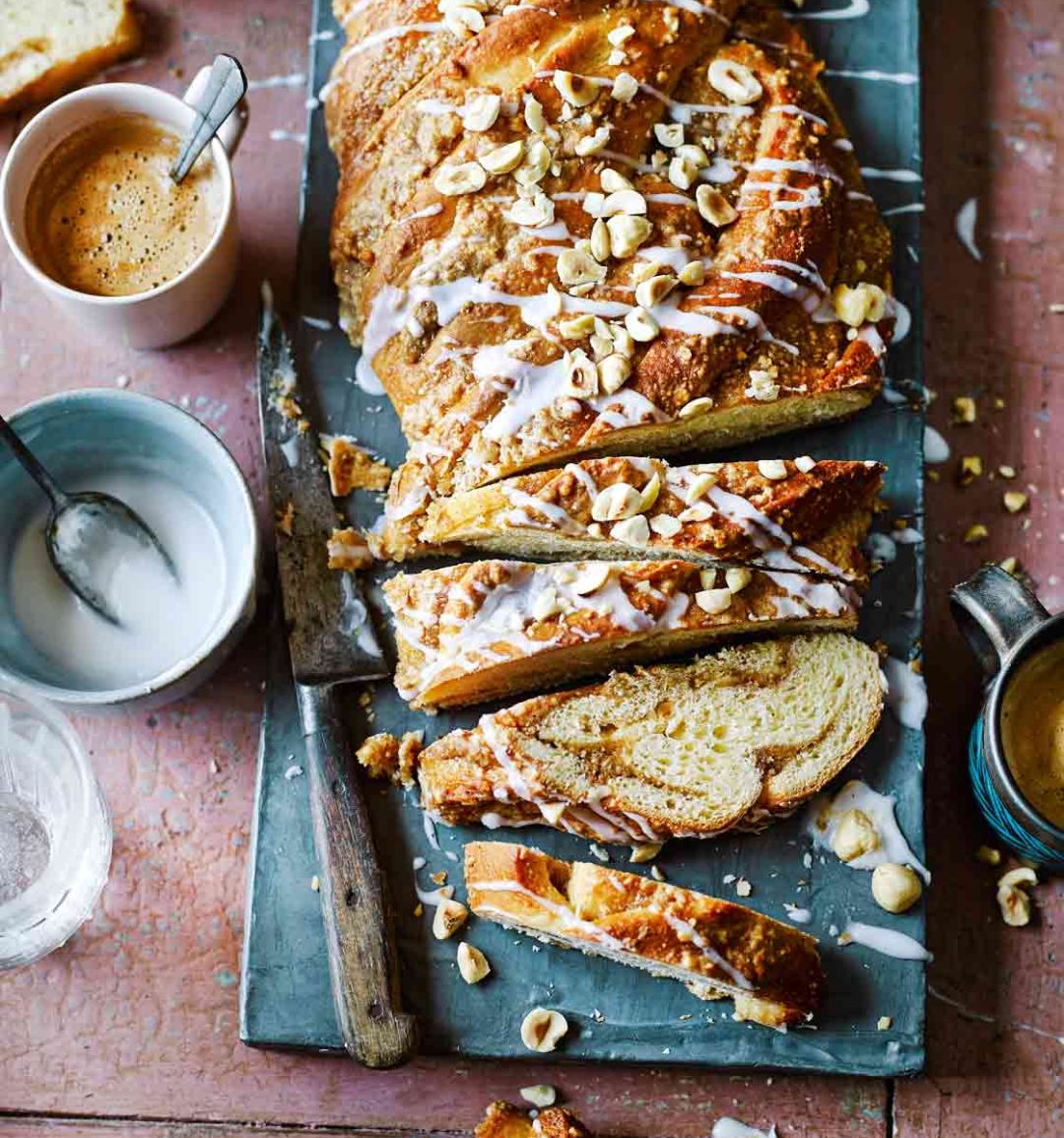Nusszopf twisted hazelnut loaf
Serves: 12

Photograph by Martin Poole
Nusszopf twisted hazelnut loaf
Serves: 12
See more recipes
Nutritional information (per serving)
Calories
351Kcal
Fat
16gr
Saturates
5gr
Carbs
47gr
Sugars
26gr
Fibre
2gr
Protein
7gr
Salt
0.2gr

Gerhard Jenne
In June 1993 Gerhard Jenne, from Freiburg Germany, is famous for his contemporary and witty cakes. He has five shops across London and a specialist Cake School. www.konditorandcook.com
See more of Gerhard Jenne’s recipes

Gerhard Jenne
In June 1993 Gerhard Jenne, from Freiburg Germany, is famous for his contemporary and witty cakes. He has five shops across London and a specialist Cake School. www.konditorandcook.com
See more of Gerhard Jenne’s recipes
Ingredients
For the bun dough:
- 300g strong white bread flour
- 1 x 7g sachet fast-action dried yeast
- 100ml milk, at room temperature
- 1 tsp honey
- 50g caster sugar
- 50g unsalted butter, softened
- 1 medium egg, lightly beaten
For the hazelnut filling:
- 125g blanched hazelnuts, finely ground in a food processor
- 125g caster sugar
- 125g sweet crumbs (we used Madeira cake, but you could also use sponge cake, scones or a mix of breadcrumbs and digestive biscuits, whizzed in a blender)
- 1 medium egg
- 1 tsp ground cinnamon
- ½ tsp ground mixed spice
- ¼ tsp vanilla extract
- 2-3 tbsp milk
To decorate:
- 75g icing sugar
- 40g blanched hazelnuts, lightly crushed
Step by step
Get ahead
Make up to the end of step 3 the night before; transfer to the fridge to slowly prove overnight. Once baked and cooled, the loaf can be frozen uniced.
- For the bun dough, I like to help the dough ferment by making a small starter to give the yeast a chance to multiply and provide the necessary lift during baking. The ideal temperature for the yeast to develop in the starter is 25°-28°C. If the other ingredients are very cold, you can warm the milk to about 30-35°C but no more, or it will kill the yeast.
- To make the starter, sift half the flour into a bowl and stir in the dried yeast. Add the milk and honey and mix together with a spatula, then use your hands to shape the dough into a smooth ball.
- Cover with clingfilm and leave for 1½-2 hours at room temperature, until it doubles in size. Alternatively, allow this to prove slowly in the fridge overnight.
- Add the rest of the flour and a small pinch of salt, plus all the remaining dough ingredients, and bring together into a rough dough. Knead it either with an electric mixer fitted with a dough hook or by hand. It might be quite sticky at first but, as you knead, it will become smoother and silkier. If you do it by hand, transfer the dough to a work surface and stretch and turn it intensively for 3-5 minutes.
- Return the dough to the bowl and cover with clingfilm. Leave for about 1 hour, or until doubled in size again, before using.
- For the hazelnut filling, preheat the oven to 180°C, fan 160°C, gas 4. Spread out the ground nuts on a baking tray lined with baking paper and toast in the oven for 5–7 minutes, until light brown. Remove from the oven and leave to cool.
- Add the nuts to a bowl with the rest of the ingredients for the filling and mix, adding enough milk to give a spreadable (but not runny) consistency. When the bun dough has risen to twice its size, roll it out on a lightly floured surface into a rough 40cm square. It's best to roll diagonally as well as from top to bottom, lifting the dough up regularly and turning it 180°. Dust with a little more flour as necessary.
- Spread the nut filling evenly over the dough, leaving about 3cm clear at the end nearest you and a slight border all the way around. Pick up the end of the dough furthest away from you and roll it towards you into a log. Rest it on its seam; it should be about 40cm long. Transfer to a large baking tray lined with baking paper.
- Using a small, sharp serrated knife, cut the dough in half, lengthways down the middle. With the pieces lying next to each other, showing their stripy innards, pick up the ends of the strands and start twisting from the middle, twisting the strands towards you so it looks like a rope. Repeat the twist with the other two ends so that you are left with one long rope-like twist.
- Cover loosely with a sheet of clingfilm to prevent a skin forming. Leave to prove for at least 45 minutes, until it has nearly doubled in size.
- Heat the oven to 180°C, fan 160°C, gas 4, and place a small heatproof dish with 100ml water in the bottom – this creates a steamy environment in the oven and keeps the outside of the loaf soft as it expands, allowing the dough to rise further for a lighter texture.
- Bake for 30-35 minutes, until the plait is golden brown and sounds hollow when tapped; you may need to loosely cover it with foil halfway through baking to prevent it from getting too dark. Remove from the oven and leave to cool slightly while you make the icing.
- Sift the icing sugar into a bowl and gradually stir in 1 tablespoon hot water until you have an icing that is thin enough to drizzle. Using a spoon, drizzle it over the loaf in irregular lines. Sprinkle with the crushed hazelnuts. Leave to cool slightly before serving warm. Cut it with a serrated knife into slices 1-2 cm thick.
Tip
The loaf takes a few hours to make, but for most of that time you can be relaxing or doing something else while the yeast does all the work.
Chef quote
This Nusszopf is the archetypal bake of southern Germany. It is light enough to have with milky coffee in the morning or with a cup of tea for elevenses, or perhaps a small helping for the traditional Kaffeeklatsch at 4pm. It's also rather good with a glass of medium-dry white wine in the evening. For extra naughtiness, I have been known to spread my slice of loaf with unsalted butter.




